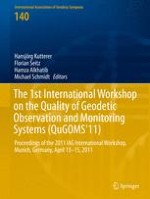2015 | Book
The 1st International Workshop on the Quality of Geodetic Observation and Monitoring Systems (QuGOMS'11)
Proceedings of the 2011 IAG International Workshop, Munich, Germany April 13–15, 2011
Editors: Hansjörg Kutterer, Florian Seitz, Hamza Alkhatib, Michael Schmidt
Publisher: Springer International Publishing
Book Series : International Association of Geodesy Symposia
